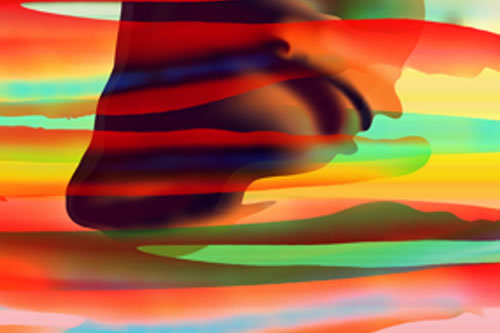Jose' Manuel Broto
dal 12/3/2009 al 8/5/2009
Segnalato da
Galeria Moises Perez de Albeniz
12/3/2009
Jose' Manuel Broto
Galeria Moises Perez de Albeniz, Pamplona
Recent Works

Broto presents in Moisés Pérez de Albéniz gallery his latest series of papers of digital painting produced in his Paris studio in 2008. Using digital techniques show his latest experiments relating to interactions of gesture, support and variation, inquiring into the digital spectra of colour.
José Manuel Broto (born in Zaragoza, 1949) is perhaps the artist who has spent most time thinking about and continuing to develop a painting of specifically pictorial analysis and syntax in our country. In 1972 he moved to Barcelona where he formed the group Trama together with Xavier Grau, Gonzalo Tena and Javier Rubio, influenced by the elaboration of French structuralism of the magazines Tel Quel and Peinture. Cahiers Théoriques, and by the praxis of the French group Support-Surface. In 1976 they created the magazine Trama, which Antoni Tàpies presented in the Galería Maeght in Barcelona, and whose theoretical approach placed the emphasis on a pictorial discourse that accentuated its specific components: support, surface and colour, in a pictorial practice as a radical alternative to artistic behaviours of a conceptual character.
His early pictures show the influence of minimalism seduced by a cold vision of painting of fields of colour, which lead him to monumentality in his formats and the utmost appreciation of colour. In the decade of the eighties, his work evolved away from the rigidity of post-minimalism and introduced gestural paths close to automatism, with streams of paint and broad brush strokes, combined with a geometry of forms or of a structural function. At all times enclosed by a two-dimensional character, Broto’s painting reveals the conciliation of a manufacture with cold as its result, the outcome of an extraordinary technical mastery in studies of almost technological gradations of colour, or in the intimate relation between support and painting which manages to become transformed into “tincture”, something which becomes naturally accentuated in his works on paper. The archetypal forms, the result of the unconscious force of automatism, give Broto’s work a character that is hermetic, yet nevertheless open in its reception and interpretation, and, in his recent exhibitions, illuminated by a work of vibrant luminic force. In 1995 he received the National Award for Plastic Arts.
Now presents the latest series of papers created in 2008 by José Manuel Broto, produced using purely digital means. His work with computers began in 1997 with series of graphic works, in which Broto traced vigorous gestures that filled the paper on backgrounds of rich and subtle colours in the steps of tonality. In this same direction, the new series shows the intimate relation between the line with optical pencil and the support, whose colours condition the discourse of his work on the entire allover plane of the paper.
His interest and relation with the world of present-day acoustic and musical composition is reflected in different collaborations with musicians and their works: from the scenery design for the opera La noche y la Palabra (2004) by José Manuel López-López and other collaborations for video with this composer from Madrid, up to collaborating on the covers for the latest discs for the choral works of Alfredo Aracil or the work for piano by López-López. All these affinities are going to be reflected in the results of his plastic art: “Faced with this situation Broto has decided to start up the spectrogram by applying it to his pallet. His latest work is not a painting with colour, it is a painting of colour. We do not find ourselves faced with any impressionism or Klangfarbermelodie.
It might be better said that his work coincides with some presuppositions of acoustic investigation and into the sound produced by French spectral music in the last twenty-five years. In the latest series, chance has become replaced by the prior work of analysis by means of computer. The backgrounds are created not by the specific choice of colours but instead by the elaboration of very complex greys, and the relations established among them are only to be understood via their timbric synthesis, modulations of temperature, genetic mutations and modifications in their interior. With his computer programmes and the use of the digital pencil Broto traces sliding glissandi or violent chromatic clusters from which fires out a spectral conglomerate of harmonics and resonances animated on the screen by the electronic light of liquid crystal. Its result, abstract and combinatory, lyrical and mystical, synthetic and introspective, is the effort to fix the colour of the flow of time in the blink of an eye.”
José Mª de Francisco, Ecos y espectros, MGEC, Málaga, 2001.
Image: Cristal XVII, 2008. Pigmented inks on paper. 200 x 100 cm.
Moisés Pérez de Albéniz gallery
Larrabide, 21. 31005 Pamplona (Spain)
Hours
Tuesday to Saturday: 10:30 to 14:00h and 17:00 to 20:30h.



